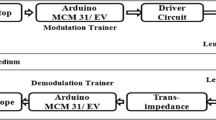ABSTRACT
This work presents a low cost vehicle-to-vehicle based visible light communication (VLC-V2V) for sending codes and instructions using the pre-availability LEDs and photodiodes. VLC is a powerful alternative method to integrate with intelligent transport systems (ITS) for road safety applications. Light from the brake lamps of a vehicle can be used to transmit instructions for emergency or sudden brake, so that the following vehicle can take precautionary measures to track it or to avoid accidents. A prototype VLC-V2V system based on Arduino/Python is designed that has low complexity and high reliability.
Experimental evaluation of the prototype shows that the system can detect emergency and sudden brakes from a distance of 2.2 m in static case and 1.2 m in dynamic case, and can provide strict brake to following vehicle, reducing the chances of road accidents, also, it can transmit the instructions to the tracked vehicle.
Access this chapter
Tax calculation will be finalised at checkout
Purchases are for personal use only
Similar content being viewed by others
References
World Health Organization: Global status report on road safety: time for action. World Health Organization (2009)
Wang, N., Qiao, Y., Wang, W., Tang, S., Shen, J.: Visible light communication based intelligent traffic light system: designing and implementation. In: 2018 Asia Communications and Photonics Conference (ACP), pp. 1–3, December 2018
Cailen, A.: Etude et réalisation d'un système de communication par lumière visible (VLC/LiFi). Optique/photonique. France, Université de Versailles Saint Quentin, Yvelines (2014)
Căilean, A.M., Dimian, M., Done, A.: Enhanced design of visible light communication sensor for automotive applications: experimental demonstration of a 130 meters link. In: 2018 Global LIFI Congress (GLC), pp. 1–4, March 2018
Martinek, R., Danys, L., Jaros, R.: Visible light communication system based on software defined radio: performance study of intelligent transportation and indoor applications. Electronics 8, 433 (2019)
Irfan, M., et al.: Optical-interference mitigation in visible light communication for intelligent transport systems applications. Energies 13, 5064 (2020)
Chaabna, A., Babouri, A., Zhang, X.: An indoor positioning system based on visible light communication using a solar cell as receiver. In: Hatti, M. (ed.) ICAIRES 2017. LNNS, vol. 35, pp. 43–49. Springer, Cham (2018). https://doi.org/10.1007/978-3-319-73192-6_5
Komine, T., Nakagawa, M.: Fundamental analysis for visible-light communication system using LED lights. IEEE Trans. Consum. Electron. 50, 100–107 (2004)
Moreira, A.J., Valadas, R.T., de Oliveira Duarte, A.M.: Optical interference produced by artificial light. Wireless Netw. 3, 131–140 (1997). https://doi.org/10.1023/A:1019140814049
Smith, R. G., Personick, S. D.: Receiver design for optical fiber communication systems. In: Kressel, H. (ed.) Semiconductor Devices for Optical Communication. TAP, vol. 39, pp. 89–160. Springer, Heidelberg (1980). https://doi.org/10.1007/3-540-11348-7_26
Author information
Authors and Affiliations
Editor information
Editors and Affiliations
Rights and permissions
Copyright information
© 2022 The Author(s), under exclusive license to Springer Nature Switzerland AG
About this paper
Cite this paper
Chaabna, A., Babouri, A., Chouabia, H., Hafsi, T., Meguetta, Z.E., Zhang, X. (2022). Experimental Demonstration of V2V Communication System Based on VLC Technology for Smart Transportation. In: Hatti, M. (eds) Artificial Intelligence and Heuristics for Smart Energy Efficiency in Smart Cities. IC-AIRES 2021. Lecture Notes in Networks and Systems, vol 361. Springer, Cham. https://doi.org/10.1007/978-3-030-92038-8_65
Download citation
DOI: https://doi.org/10.1007/978-3-030-92038-8_65
Published:
Publisher Name: Springer, Cham
Print ISBN: 978-3-030-92037-1
Online ISBN: 978-3-030-92038-8
eBook Packages: Intelligent Technologies and RoboticsIntelligent Technologies and Robotics (R0)




